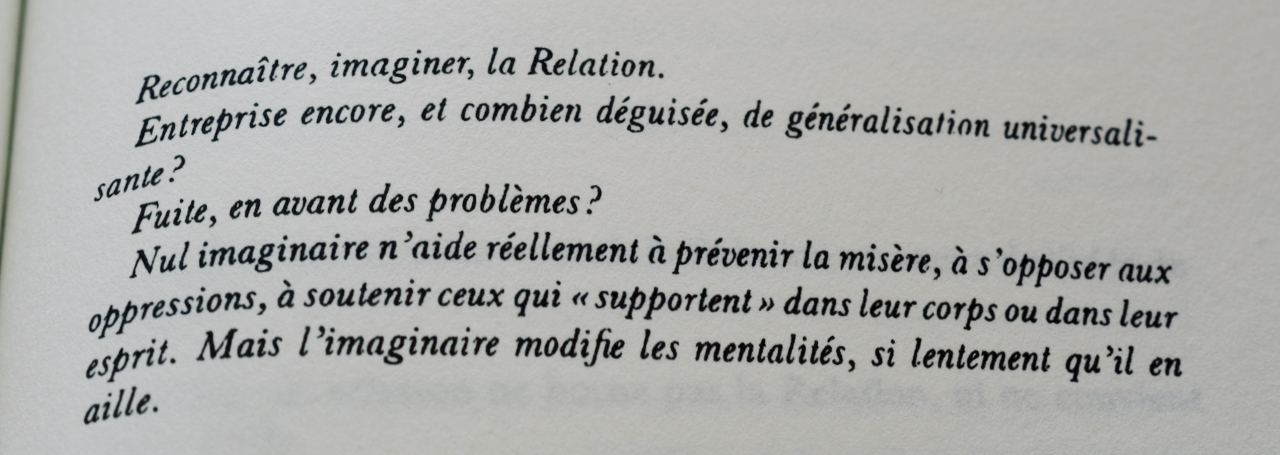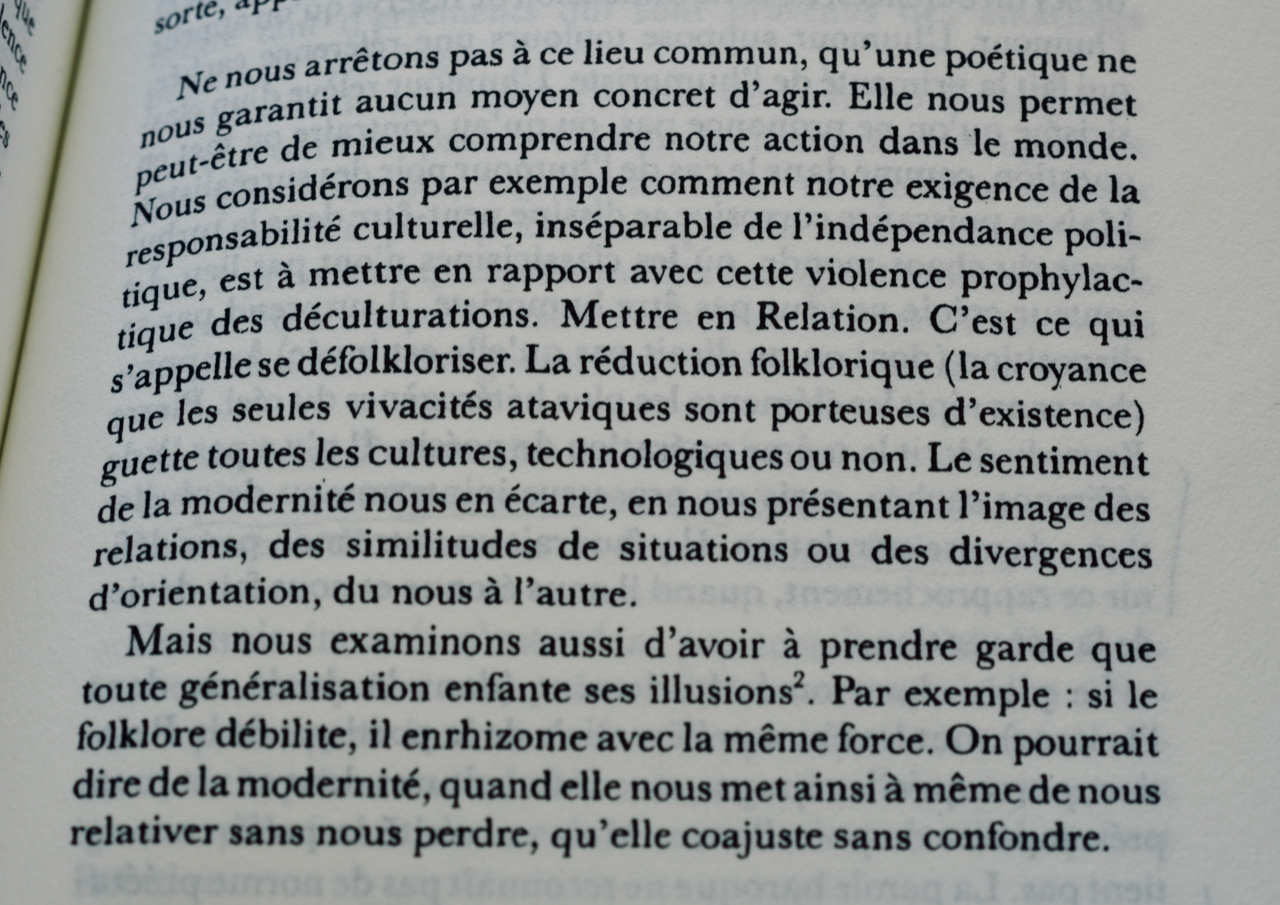
I was introduced to Édouard Glissant rather recently, through a former and a future colleague, both writing their PhDs on Glissant’s work, and it was from the very beginning that his writing constructed a bridge between many spaces that, at the time, had seemed quite apart. This bridge ran across the temporal and the spatial, but most importantly across disciplinary and theoretical fields all too neatly compartmentalized in my mind. I still fed off that gush of excitement I sense in so many who read Gilles Deleuze and Félix Guattari, a sense of radicality expressed in terms of a poetics and a kinship with an other that remains, to some extent, fuzzily unknown.
But D&G, for me, also clashed with a model of critique that acknowledged the violence and alienation which had been a dehumanizing force in shaping the world as I – they – knew it, Women of Colour feminisms’ insistence on standpoint politics. Having read D&G, I found comfort and solace in the idea that one need not reclaim problematic authenticity to formulate critique, and yet the notion that uprootedness and deterritorialization was always productive seemed oblivious to the racial grammar and the gendered matrix inherent to the narrative of historical progress. Celebrating those who had been violently pushed to the margins by “becoming” (with) them seemed somehow benevolently paternalistic and entrenched in romantic notions of nature or the wild, and thus authenticity re-emerged in a perspective that proved problematic simply on a different level. Reading Glissant made this discomfort explicit, just as his friendship with Deleuze and Guattari embedded their language in his, clarified what they had perhaps merely hinted at.
I cannot claim to have fully grasped Glissant’s poetic melancholy, and I write this with the wide-eyed approach of a novice. Then again, all that might make perfect sense, given that transparency does not, in his writing, hold a desirable place, nor does arriving, as such. And so I wrangle with his words and translate them into my world, connecting and associating rather than, perhaps, fully understanding. Of course, the antagonism of identity and multiplicity has been negotiated across the board, and Glissant is not alone in acknowledging the porosity and contamination that creates cultures, identities, worlds. However, his map to elsewhere is both perfectly clear and shrouded in what seems to be both a demand and a method – the right to opacity.
Transparency, to Glissant, is a reduction. How can this not resonate with the several scales on which those who have been marginalized are made to relive their trauma, to make it believable and accessible, in order to have even a chance of gaining recognition and redress? I see variations of that trauma impacting intersectional thought and it speaks to the who and what of being a woman, a concept that often wrangles with being “not-man”, and the violence experienced because of it. Even in this text, “man” may be overly present, gaping at me from these lines that I write, as I sit with womanhood and its various theorists, bodies, practitioners that, here as everywhere, remain underacknowledged. Perhaps, beginning with this very limited canon of men, I have already failed my own goal of drawing on perspectives that complicate “man” in other ways than Glissant does. And yet, ever so often, the concept of “man” seems nothing more than that, an ephemeral ideal that expresses a systematic position of power the wretched of whatever gender cannot hold. And so we move around it, approach it and perhaps also indent it with our thoughts, rearranging our bodies to at times fit, at times contest our positions in relation to it.
We?
As I revise this text, violence has revealed itself as the thread that weaves the texture of the social. Again. A man has been murdered. Again. And still, I sit uselessly with womanhood and wonder about relation and appropriation, while bodies push forward and are met with more of the same. I want to say his name, because it might grant him a right others have denied. I want to say his name, yet naming him carries the sensation of alienation and failure: who am I to grant anything, to anyone? I want to say his name because not making the reality of violence explicit was what made me suspicious of D&G. His name was George Floyd. But saying his name entails more names: João Pedro Matos Pinto, Breonna Taylor, Pamela Turner, Eric Garner, Oury Jalloh, Christy Schwundeck… The list is too long, it invokes even greater despair, not just for lives lost, but because these names will match the fate of others, whose humanity remains unacknowledged, whose deaths are, for some, interchangeable, merely blackening social media feeds, while they completely erase others’ voices and strength, others’ sense of futurity and safety, of life and of worth. This is the systemic relation that presents itself even before it is embodied by (white) murderers.
What in this moment seems suddenly easy for many is difficult on any other day. The “we” struggles to be formed at different levels, each fighting to be heard, sometimes with and sometimes against each other. That one concept, “man”, as white, hetero, capitalist, bourgeois infrastructure, as that which sustains the social, remains – imperturbable, lazily beckoning whom it considers worthy, oozing here and there, softly tracing a shoulder blade, gently enveloping a spine. Relations pull together, as “we” stumble to rise up against its systemic injustices and towards liberation – joyfully, angrily, passionately, desperately. On another day, some of us may be privileged enough to forget it exists, merely fatiguing into its arms. Relations violently pull apart as those who cannot forget rage over the fact that others do, rage over others’ inability to understand that their rage is just a response to existing relations.

Recognizing, imagining, Relation.
Yet another undertaking, thoroughly disguised, of universalizing generalization?
Escape, the problems at our heels?
No imagination helps avert destitution in reality, none can oppose oppressions or sustain those who “withstand” in body or spirit. But imagination changes mentalities, however slowly.
“We” is always already. But it cannot be productive in a simple assertion of multiplicity. If anything, it is a process; an acknowledgement of mobility that occurs precisely because of violence. An invitation to recognize that to act means to have been acted upon, to have been arranged and put in a place. “We” struggle together just as we struggle with, “we” resist our positioning from the location of that position that leaves little room to engage, merely room to react.

Let us not stop with this commonplace: that a poetics cannot guarantee us a concrete means of action. But a poetics, perhaps, does allow us to understand better our action in the world. We consider, for instance, how our requirement for cultural responsibility, inseparable from political independence, is to be related to the prophylactic violence of forms of deculturation. …
“We” is a slippery concept, constantly becoming, constantly failing. But it is also an invitation to burn the system that sustains these realities to the ground, to not merely act against individuals to pacify the masses. “We” is unavertable – “we” needs to be unearthed. “We” is laborious, just as it is a fantasy – “we” must be critical of the “we”. Acting in the name of liberation remains opaque, a complex negation and affirmation, both of identity and its fixation.
Sara Morais dos Santos Bruss